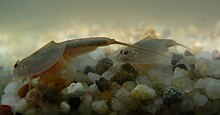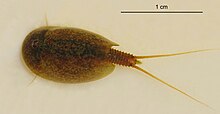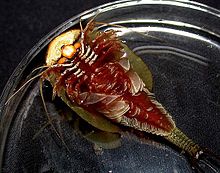Notostraca
| Notostraca Temporal range:
| |
|---|---|

| |
| Triops australiensis | |

| |
| Lepidurus apus | |
| Scientific classification | |
| Kingdom: | |
| Phylum: | |
| Subphylum: | |
| Class: | |
| Subclass: | |
| Order: | Notostraca G. O. Sars, 1867
|
| Family: | Triopsidae Keilhack, 1909
|
| Genera | |
The order Notostraca comprises the single family Triopsidae, containing the tadpole shrimp[1] or shield shrimp.[2] The two genera, Triops and Lepidurus, are considered living fossils, having not changed significantly in outward form since the Triassic. They have a broad, flat carapace, which conceals the head and bears a single pair of compound eyes. The abdomen is long, appears to be segmented and bears numerous pairs of flattened legs. The telson is flanked by a pair of long, thin caudal rami. Phenotypic plasticity within taxa makes species-level identification difficult, and is further compounded by variation in the mode of reproduction. Notostracans are omnivores living on the bottom of temporary pools and shallow lakes.
Description
Notostracans are 2–10 centimetres (0.8–3.9 in) long, with a broad carapace at the front end, and a long, slender abdomen.[1] This gives them a similar overall shape to a tadpole, from which the common name tadpole shrimp derives.[1] The carapace is dorso-ventrally flattened, smooth, and bears no rostrum; it includes the head, and the two sessile compound eyes are located together on top of the head.[1] The two pairs of antennae are much reduced, with the second pair sometimes missing altogether.[2] The mouthparts comprise a pair of uniramous mandibles and no maxillipeds.[2]

The trunk comprises a large number of "body rings", which appear to be body segments, but do not always reflect the underlying segmentation.[1] The first eleven body rings compose the thorax and bear one pair of legs each, the last of which also bears the genital opening.[1] In the female, it is modified to form a "brood pouch".[3] The first one or two pairs of legs differ from the remainder, and probably function as sensory organs.[3]
The remaining segments form the abdomen. The number of body rings is variable both within and between species,[1] and the number of pairs of legs per body ring can rise as high as six.[4] The legs become progressively smaller along the abdomen,[3] with the last segments being legless.[1]
The abdomen ends in a telson and a pair of long, thin, multi-articulate caudal rami.[5] The form of the telson varies between the two genera: in Lepidurus, a rounded projection extends between the caudal rami, while in Triops there is no such projection.[1]
Life cycle

Within the Notostraca, and even within species, there is variation in the mode of reproduction, with some populations reproducing sexually, some showing self-fertilisation of females, and some showing a mix of the two.[1] The frequency of males in populations is therefore highly variable.[3] In sexual populations, the sperm leave the male's body through simple pores, there being no penis. The eggs are released by the female and then held in the cup-like brood pouch.[3] The eggs are retained by the female only for a short time before being laid,[4] and the larvae develop directly, without passing through a metamorphosis.[2]
Ecology and distribution
Notostracans are omnivorous, eating small animals such as fishes and fairy shrimp.[1] They are found worldwide in freshwater, brackish water or saline pools, as well as in shallow lakes, peat bogs and moorland.[2] In Californian rice paddies, the species Triops longicaudatus is considered a pest, because it stirs up sediment, preventing light from reaching the rice seedlings.[6]
Evolution and fossil record
The fossil record of Notostraca is extensive, occurring in a wide range of geological deposits, and reaching back to the Carboniferous.[7] The lack of major morphological change since 250 million years ago has led to Notostraca being described as a living fossil.[8] Kazacharthra, a group known only from Triassic and Jurassic fossils from Kazakhstan and Western China,[9] are closely related to notostracans, and may belong within the order Notostraca.[10]
The "central autapomorphy" of the Notostraca is the abandonment of filter feeding in open water, and the development of a benthic lifestyle in muddy waters, taking up food from particles of sediment and preying on small animals.[4] A number of other characteristics are correlated with this change, including the increased size of the animal compared to its relatives, and the loss of the ability to hinge the carapace; although a central keel marks the former separation into two valves, the adductor muscle is missing.[4] Notostracans retain the plesiomorphic condition of having two separate compound eyes, which abut, but have not become united, as seen in other groups of Branchiopoda.[4]
Taxonomy
The order Notostraca is composed of a single family, Triopsidae, and only two genera, Triops and Lepidurus.[8]
The phenotypic plasticity shown by notostracan species make identification to the species level difficult.[8] Many putative species have been described based on morphological variation, such that by the 1950s, as many as 70 species were recognised.[8] Two important revisions – those of Linder in 1952[11] and Longhurst in 1955[12] – synonymised many taxa, and resulted in the recognition of only 11 species in the two genera. This taxonomy was accepted for decades,[8] "even attaining the status of dogma".[13] More recent studies, especially those employing molecular phylogenetics, have shown that the eleven currently recognised species conceal a greater number of reproductively isolated populations.[8]
See also
References
- ^ a b c d e f g h i j k Denton Belk (2007). "Branchiopoda". In Sol Felty Light; James T. Carlton (eds.). The Light and Smith Manual: Intertidal Invertebrates from Central California to Oregon (4th ed.). University of California Press. pp. 414–417. ISBN 978-0-520-23939-5.
- ^ a b c d e J. K. Lowry (October 2, 1999). "Notostraca (Branchiopoda)". Crustacea, the Higher Taxa: Description, Identification, and Information Retrieval. Retrieved February 7, 2011.
- ^ a b c d e Douglas Grant Smith (2001). Pennak's freshwater invertebrates of the United States: Porifera to Crustacea (4th ed.). John Wiley and Sons. ISBN 978-0-471-35837-4.
- ^ a b c d e Peter Ax (2000). "Notostraca". Multicellular Animals. The Phylogenetic System of the Metazoa. Volume II. Springer. pp. 158–159. ISBN 978-3-540-67406-1.
- ^ "Subclass 1. Branchiopoda". The Invertebrata (4th ed.). Cambridge University Press. 1961. pp. 368–375.
- ^ Hugh F. Clifford (1991). "Notostraca: tadpole shrimp". Aquatic Invertebrates of Alberta: an Illustrated Guide. University of Alberta. pp. 144–145. ISBN 978-0-88864-234-9.
- ^ Atte Korhola; Milla Rautio (2001). "Cladocera and other branchiopod crustaceans". In John P. Smol; Harry John Betteley Birks; William M. Last (eds.). Tracking Environmental Change Using Lake Sediments. Volume 4: Zoological Indicators. Kluwer Academic Publishers. pp. 5–41. ISBN 978-1-4020-0658-6.
{{cite book}}: Unknown parameter|lastauthoramp=ignored (|name-list-style=suggested) (help) - ^ a b c d e f Luc Brendonck, D. Christopher Rogers, Jorgen Olesen, Stephen Weeks & Walter R. Hoch (2008). Estelle V. Balian; Christian Lévêque; Hendrik Segers; Koen Martens (eds.). "Freshwater Animal Diversity Assessment". Hydrobiologia. Developments in Hydrobiology 198. 595 (1): 167–176. doi:10.1007/s10750-007-9119-9. ISBN 978-1-4020-8258-0.
{{cite journal}}:|chapter=ignored (help)CS1 maint: multiple names: authors list (link) - ^ Liu, Hongfu (1996). "New materials of Late Triassic Kazacharthra from Xinjaing". Acta Palaeontologica Sinica. 4 (35): 490–494.
- ^ Marjorie L. Reaka-Kudla (2002). "Habitat specialization and its relation to conservation policy in Crustacea". In Elva Escobar-Briones & Fernando Alvarez (ed.). Modern Approaches to the Study of Crustacea. Springer. pp. 211–221. ISBN 978-0-306-47366-1.
- ^ Folke Linder (1952). "Contributions to the morphology and taxonomy of the Branchiopoda Notostraca, with special reference to the North American species". Proceedings of the United States National Museum. 102 (3291): 1–69. doi:10.5479/si.00963801.102-3291.1.
- ^ Alan R. Longhurst (1955). "A review of the Notostraca". Bulletin of the British Museum (Natural History). 3 (1): 1–57.
- ^ Clay Sassaman, Marie A. Simovich & Michael Fugate (1997). "Reproductive isolation and genetic differentiation in North American species of Triops (Crustacea: Branchiopoda: Notostraca)". Hydrobiologia. 359 (1–3): 125–147. doi:10.1023/A:1003168416080.
External links
- Triops cancriformis media from ARKive
- L. D. Godfrey; L. A. Espino (February 2009). "Tadpole shrimp. Scientific name: Triops longicaudatus". UC Pest Management Guidelines. University of California, Davis.
{{cite web}}: Unknown parameter|lastauthoramp=ignored (|name-list-style=suggested) (help)  Data related to Notostraca at Wikispecies
Data related to Notostraca at Wikispecies

